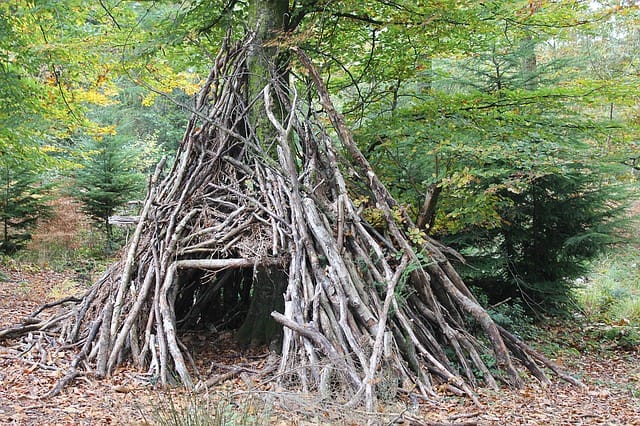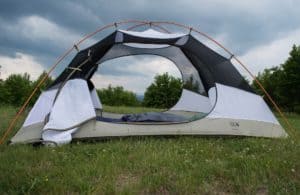Camping Shelter Ideas
When camping, a shelter can take many forms, from a natural camping shelter made from materials found in nature to a high tech tent with all the bells and whistles and everything in between.
No matter which type of shelter you chose though it’s important to know their advantages, limitation, and best practices.
Below is a list of some camping shelter ideas to give you a better idea of your shelter options while camping.
Natural Camping Shelter
While this type of shelter will not appeal to most, what better way to get back to nature than by building your actual shelter out of nature itself?
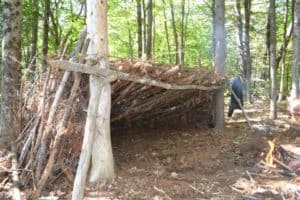 When using nature and natural resources found in the wild there is no right or wrong way to construct or build a camping shelter. The most important thing no matter what shape your camping shelter takes is that it provides protection and shelter from the elements while camping.
When using nature and natural resources found in the wild there is no right or wrong way to construct or build a camping shelter. The most important thing no matter what shape your camping shelter takes is that it provides protection and shelter from the elements while camping.
Some of the more popular natural camping shelters include lean-to structures constructed from branches and leaves, rock overhangs, and natural caves.
If constructing a lean-to style shelter make sure that any heavy branches and logs are secured well and are stable to prevent accidental collapse. Also in the same line of reasoning if using rock outcroppings or caves make sure they seem stable and secure before resting underneath them.
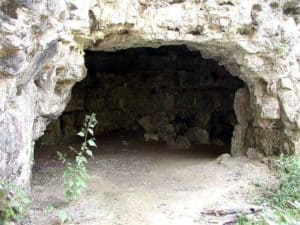 Finally, if you plan to use a natural cave as a shelter make sure that you are the only one using it especially in bear country! After all, the last thing you want is to be woken up in the middle of the night by an unhappy wildlife roommate.
Finally, if you plan to use a natural cave as a shelter make sure that you are the only one using it especially in bear country! After all, the last thing you want is to be woken up in the middle of the night by an unhappy wildlife roommate.
Natural shelters are best suited for experienced campers, with skills in using natural materials for building and construction.
Tarp Camping
The basic tarp can be your best friend and serve a multitude of purposes while around the campsite. But you might not have thought about using a simple tarp as your shelter while camping.
While using a tarp for shelter is not going to win any extra points for comfort or luxury it does provide a limited amount of protection from the elements keeping you dry and out of the wind. While using a tarp for shelter is not going to be a good fit for most campers if you’re looking for a lightweight alternative to the standard tent and want to explore minimalist or lightweight camping it’s definitely worth a try.
Using a tarp for shelter while camping can take many forms but it typically consists of a tarp with some sort of center support and a few tent stakes to hold it down and in place. There is nothing elaborate or fancy about this type of shelter and for those that love lightweight camping that’s the whole point. It allows you some level of protection from the elements but still allows you to feel connected to nature while sleeping outdoors.
The basic tarp is best suited for an experienced camper that is looking to cut weight from their camping gear and wants to enjoy a more minimalist camping experience.
Standard Tent
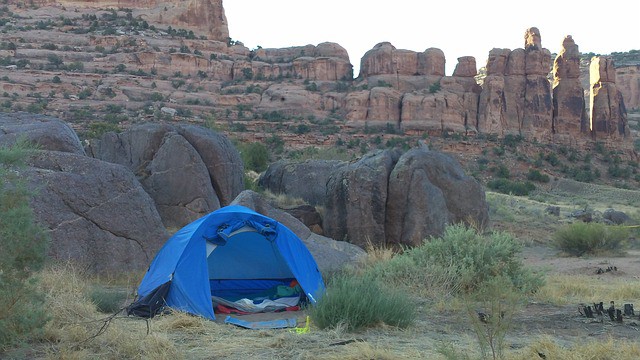 The standard tent design has been around for thousands of years and remains the top choice for campers to this day because it’s simple and it just works.
The standard tent design has been around for thousands of years and remains the top choice for campers to this day because it’s simple and it just works.
While the standard tent can come in many different shapes and sizes the basic concept is little changed from thousands of years ago. The standard tent design typically consists of an inner frame that supports either canvas or synthetic material that creates an enclosure providing protection and safety from the elements.
Today’s modern tents can sleep anywhere from 1 to over 8 people at a time and they typically use a mixture of materials such as nylon, synthetic fiber, and mesh for their waterproof, lightweight, and breathable properties. Modern tent design also offers an endless amount of options and features such as self-standing setup, window screens, and even lights and fans.
A standard tent is a great option for all types of campers because of its excellent versatility and usability. Whether you are brand new camper looking to buy your first basic tent or an experienced thru-hiker and camper that needs a high-end tent to handle extreme conditions you are sure to find a tent that fits the bill.
Hammock Tent
One of the most exciting new tent designs to hit the market in recent years is the hammock tent. If you have never heard of a hammock tent before its simple a tent that uses a hammock design.
Just like a standard hammock, it’s usually suspended from two points. Where the tent hammock differs from the standard hammock though is its enclosure. Typical tent hammock enclosures are made from nylon and mesh that encapsulates the camper while sleeping.
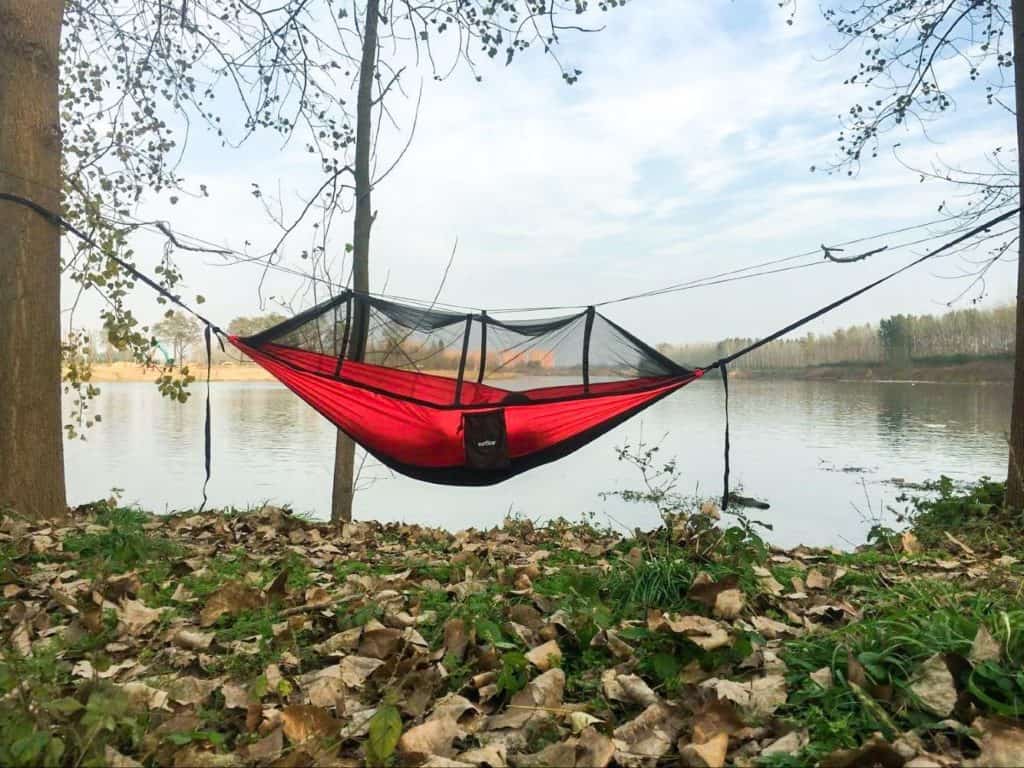
There are many great benefits to using a hammock tent while camping including an elevated sleeping height which creates a barrier from insects and snakes. Also using a hammock tent can help you stay cooler during those hot summer nights as the elevated hammock allows air to flow above and below the camper creating a cooling sensation.
The hammock tent is great for all campers that are looking for a fun and exciting twist on the standard tent.
Camping Bed Tent
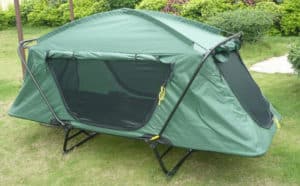 Another recent upgrade to the standard tent design is the camping bed tent which is a tent enclosure that sits on top of a camping cot. Camping bed tents offer an unmatched level of comfort while camping because of its elevated platform.
Another recent upgrade to the standard tent design is the camping bed tent which is a tent enclosure that sits on top of a camping cot. Camping bed tents offer an unmatched level of comfort while camping because of its elevated platform.
There are many benefits to the camping bed tent as opposed to the standard tent including a more comfortable and better night’s sleep, protection from insects and snakes, and more airflow because of the elevated sleeping position for additional comfort.
Keep in mind though If you are trying to camp lightweight and will be hiking or traveling with your camping gear the camping bed tent is not the best choice. As typically camping bed tents are substantially more heavy and bulky compared to a standard tent.
The camping bed tent makes a great shelter for campers of all skill levels looking for the ultimate in comfort and relaxation while car camping.
How Much Does the Average Tent Weigh and What’s a Good Tent Weight?
Tents come in all different shapes and sizes so there really isn’t just one average or standard tent weight that fits all tents. There are however some general ranges for tent weights depending on sleeping capacity and intended purpose which is broken down below to give you a better idea of typical tent wents depending on your camping situation.
When considering tent weight the most important thing to consider is what type of camping you will be doing. Tents can be broken down into two main categories when it comes to weight consideration including tents used for car camping which tend to be on the heavier side and backpacking tents that tend to be on the lighter side.
Car Camping Tent Weight
With car camping tents weight is not a major concern as you will be removing and setting up the tent within a short distance of your vehicle. Camping at a campground at a designated campsite is a good example of car camping. Typically when car camping one is usually more interested in added features and luxuries as opposed to the lowest tent weight possible. Car camping tents typically range in weight from approximately 10 pounds to over 50 depending on size and features. A good example of a car camping tent is the camping bed tent mentioned above that can easily weigh more than 25 pounds.
Back Packing Tent Weight
On the flip side is the backpacking tent when weight is a big concern because you are typically hiking or traveling to your campsite on foot. With a backpacking tent, every extra ounce of weight adds additional weight to your overall pack weight causing you to exert more energy and fatigue quicker. Typical backpack or hiking tents can weigh under 3 pounds and up to 10 depending on the size and features of the tent.
No matter what type of tent you choose though whether it be a car camping tent or a backpacking tent there is no greater impact to a tent’s weight than the number of campers the tent can sleep. Obviously, the more people the tent can sleep the larger the tent needs to be and the heavier the tent will be. So when considering tent weight make sure to pick a tent that accommodates the number of campers you have and no more. In general 2.5 pounds of weight is added to the tent per occupant added.
So armed with this information what is a good tent weight that you should try to stay under? If hiking and backpacking with your tent and weight is a concern which it should be, it’s a good idea to keep the tent weight as close as possible to or under 4 pounds.
If car camping where weight is not a major concern and comfort takes a more center stage its still not a bad idea to be mindful of tent weight as the heavier the car camping tent is the more bulky and awkward it will be. A good car camping tent weight to stay under if you like to stay on the lighter side of car camping tent weights is 20 pounds.
What to Look for When Buying a Tent
There are many things to consider when purchasing a tent for your camping excursions and it all starts with sleeping capacity.
Tent Sleeping Capacity
Tent selection always starts with selecting the correct tent size based on your needs and the size of your camping party. When selecting the appropriate tent size remember that you not only need to have room for you and your camping party but also their camping gear and yours. Also when selecting the correct tent size don’t forget about any furry friends that you might have that need a place inside the tent as well.
It’s not a bad idea when selecting the correct tent size to round up by one camper if weight is not a major concern, to allow for gear, pets, and some additional space to increase everyone’s comfort level. So if your camping party contains two people, consider purchasing a three-person tent and so on.
Don’t go overboard with this concept though and buy more tent than you need, remember the more tent you have the heavier it is and longer it takes to set up and tear down.
Seasonal Ratings for Tents
When considering tent seasonality they are three main options available including 3 season tents, 3+ season tents, or 4 season tents. When choosing the appropriate tent seasonality you need to consider the type of weather you will be camping in.
3 Season Tent
For most campers, a 3 season tent will offer more than enough protection while camping. 3 season tents are a great lightweight option when camping during the most popular camping seasons including spring, summer, and early fall. They typically offer many mesh screens to keep the bugs out and allow for ample ventilation when the weather warms up. Also with the rainfly attached, they offer adequate protection for light to moderate rain showers when the weather turns South.
3+ Season Tent
If you are planning on camping in areas that experience more extreme weather including heavy thunderstorms, higher winds, and light to moderate snow than you might need to upgrade to a 3+ season tent. 3+ season tents typically have additional tent pole supports which provide extra support for heavy downpours or light snow accumulation. They also have fewer mesh panels to provide extra warmth on those colder nights.
4 Season Tent
The 4 season tent offers the ultimate level of protection while camping in extreme or cold weather climates. 4 season tents are typically made from heavier fabrics, have additional support poles, fewer mesh screens, and have a rainfly that extends all the way to the ground. All of these features of the 4 season tent are meant to provide the ultimate in protection from high winds, heavy snowfall, and cold temperatures. Keep in mind though that all of this extra protection comes at a cost of a heavier tent with less ventilation when the weather turns warmer.
Just like you tailor your clothing to the weather it’s important to tailor your tent to the weather as well. Choosing the appropriate tent based on seasonality will assure that your comfortable no matter what the weather is outside.
Top Tent Features
When choosing a tent there a few key features that you need to keep in mind. The first thing to consider is the actual tent dimensions and style of the tent.
Tent Dimensions
When looking at tent dimensions check out two main measurements the first one being peak height which is the height of the tent at the center and the highest point. This measurement is important because the higher that measurement the easier it will be to move around inside the tent. Keep in mind though that the taller the tent is the more top heavy it will be and susceptible to failure or collapse in high winds.
The next dimension to look at is the actual footprint of the tent, this is the floor space you have inside the tent. Typically the higher the sleeping capacity the larger the tent footprint will be. However, you will find that even on a stated one-person tent, footprint dimensions can and do vary from tent to tent.
Next, look at the actual design of the tent, there are two main tent designs on the market including cabin-style tents and dome-style tents.
With a cabin-style tent, the exterior walls are almost vertical with just a slight angle towards the center of the tent. This type of tent design is great for larger tents where more space and comfort is the key concern. The other main tent design is the dome-style tent which has a good center height but has tent walls that aggressively slope towards the outer edge of the tent reducing living space and ease of movement inside the tent. However, what you lose in living space you make up for with tent strength and stability. As dome-style tents generally can withstand high winds, heavy rain, and snow better that cabin-style tents.
Tent Material and Poles
Most modern tents use synthetic materials that provide the best protection from the elements at the lightest weight possible.
When shopping for your tent though be aware that not all synthetic materials are equal. Higher denier-material is more durable and rugged compared to lower denier-materials.
Also, heavier seem tape and double-lined or rugged tent floors go along way in keeping you dry and preventing leaks.
Most modern tents are free-standing meaning that they do not require staking to be set up. This allows for a much easier tent set up, allowing you to move the tent around before you stake the tent down in its permanent location. When considering tent structure and poles remember that fewer poles will mean easier set up but will also reduce the strength and sturdiness during inclement weather or high winds.
Doors and Ventilation
Tents offer a wide range of doors and ventilation options. When choosing a tent think about the number of doors and windows you will need as well as their desired size and orientation on the tent.
A little forethought and planning now will ensure that you pick the tent that best meets your needs when it comes to doors and ventilation for your tent.
Rainfly and Vestibules / Garages
One final item to consider when picking out a tent is the type of rainfly offered and whether there are any vestibules or garages included.
A rainfly is a separate waterproof cover that detaches from the tent that provides extra protection from rain and dew as well as a little extra warmth while camping. There are two main types of rain-flies including a roof rainfly which as the name implies only covers the roof of the tent allowing for more natural light and a full-coverage rainfly that goes all the way to the ground which provides more protection from the elements.
Each type of rainfly has its advantages and disadvantages when choosing between the two rainfly options keep in mind the type of camping you will be doing. If camping in an area that is known for heavy rains and cooler weather the full coverage rainfly will be the better choice. If however you are camping in an area with more mild or warmer weather and want maximum airflow and ventilation then a roof rainfly will be the better choice.
Vestibules and Tent Garages can make a great addition to any tent. In essence, they are shelters or awnings that attach to the tent providing some additional covered space to help keep things dry while camping. Vestibules and garages can be a great place to store extra gear or your hiking boots and is definitely a nice feature to have.

